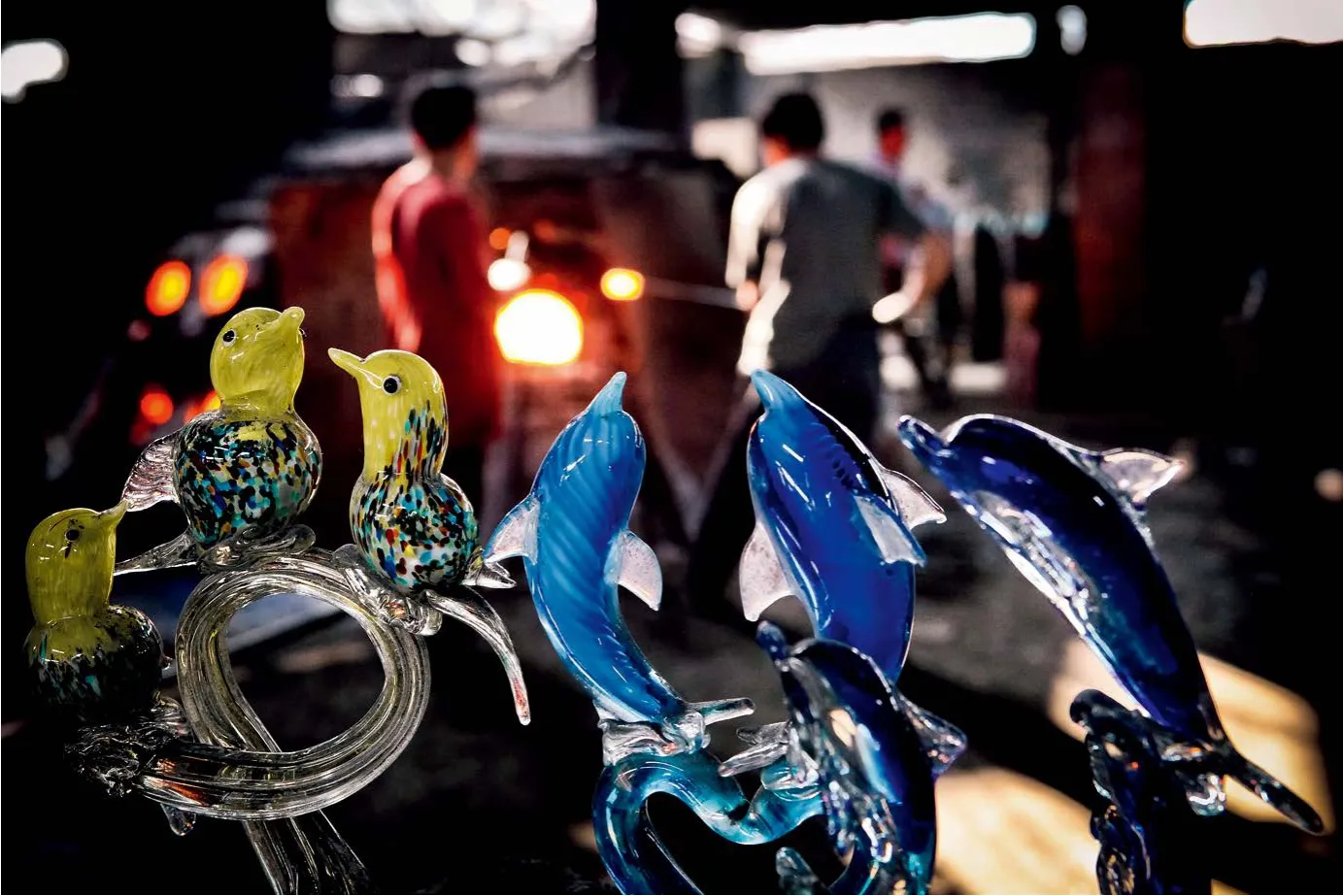炉神庙,传承不灭的琉璃之火
2018-08-17

○博山炉神庙,历经400多年风雨沧桑。图/何延海The Furnace God Temple of Boshan, undergoing 400 years of vicissitudes.
坐落在孝妇河西岸琉璃园的博山炉神庙,建于明万历三十九年(1611年)。400多年时间里,炉神庙与博山琉璃文化息息相关,见证了博山琉璃业的兴衰枯荣。曾作为博山琉璃业公众醮会(民间祭祀迎神的活动)之所的炉神庙,在今日时空下,彰显出更多的精神意义。重又复兴的炉神庙内拜师收徒的风俗,传承着源远流长的琉璃文化。
凝聚炉行精神
北京故宫博物院原院长杨伯达曾说过:“炉神文化在淄博,别无二家。”其实,炉神庙供奉的就是华夏民族人文先始女娲。相传,女娲炼石补天时所用的“五色石”就是琉璃。所以,博山炉行(即琉璃行业)就把女娲氏认作本行的“祖师”。炉神庙始建之初,博山琉璃生产发展已有相当大的规模。炉行内的徐应元首先倡议,并征得了当地著名炉行士绅孙延寿的支持,共同集资建了这座庙,庙名定为“祖师炉神庙”。
明万历四十六年(1618年),博山炉行由徐应元、孙延寿、房宗义3人为首,邀集业内23人共同结成“炉行醮会”。他们规定每年的上巳日(农历三月初三)为祭祀祖师的日子。每到这一天,全炉行都要歇业停产,到炉神庙共同举行祭祀活动。这种行业性的祭祀活动世代相沿,逐渐形成了博山农历三月初三举办“炉神庙会”的习俗。
虽然初建时的炉神庙规模甚小,只有3间殿堂,但是随着博山琉璃业日益繁荣,炉神庙地位提升,不断被翻修扩建。2006年,博山炉神庙被定为省级重点文物保护单位。即便历经数百年,炉神庙女娲像眉目依然清晰可辨,殿堂纹饰精美绝伦,沧桑中透出浓浓的历史沉淀之感。
见证沧桑变迁
400多年来,博山炉神庙一直作为博山琉璃业的象征,将当地琉璃艺人、炉匠凝聚在一起,它的兴衰也反映了博山琉璃业的荣枯。炉神庙建成后,博山琉璃业日益兴盛。博山作为明清官炉之一,成为当时中国最大的琉璃生产基地和产品集散地之一。
至道光四年(1824年),炉神庙香火丛集,因原庙址地势狭窄,曾在京城做过兵部职方司主事的蒋天钧和做过大理寺评事的蒋天修两兄弟“于庙后施宅基一区,以为(炉神庙)晨拓之地”。又经后人重塑女娲像,扩大原址,基本上奠定了现存炉神庙的规模。史料《重修炉神庙碑记》中写道:“雕甍锈阔,金耀丹流。遥接文峰,近临孝水。来者每低徊留之而不能去。”昔日炉神庙庄严华美可见一斑。
然而,至咸丰十一年(1861年),捻军攻入博山,炉神庙受到一定的损坏。到同治十二年(1873年),炉神庙又一次重修,并加塑一座火帝神像,反映了博山炉行“熔炼之功莫大于火”“火帝之功不可不报”的思想观念。
晚清以后,国家动荡,战乱不断,人们已无暇关注作为装饰用品的琉璃,博山琉璃业一度没落,炉神庙也因此逐渐被人遗忘,改作他用。直到中华人民共和国成立之后,博山琉璃事业继续发展。曾被用作学校、印刷厂的炉神庙终于在上世纪80年代末期恢复原貌,重新修缮,周边建成琉璃园,其历史地位得以再现。近年来,国家重视传承传统工艺,挖掘地方传统文化精髓,博山琉璃也不断探索出路,振兴产业,炉神庙传统开始复兴。

○博山琉璃,火的艺术。图/袁会华The colored glaze of Boshan, the art of fire.
复兴老庙传统
经过400多年的历史变迁,昔日炉行醮会的壮观景象已不见,炉神庙会依旧热闹。如今,博山的琉璃艺人们仍在为复兴炉神庙的精神文化价值而不懈努力着。
近年来,“中国石榴王(琉璃)”王乃宝、“中国孙氏琉璃鸡油黄”孙即杰、“中国琉璃内画张”张广忠等琉璃艺术大师拜师收徒仪式全部在炉神庙举行,炉神庙逐渐成为复兴琉璃工艺传统的精神“根据地”。
现在,炉神庙迎来了一批又一批拜师学艺的年轻人,老师傅与徒弟们一起瞻仰女娲像,不忘传统,与时俱进,推陈出新,精益求精,使琉璃艺术之火永续。
编辑/郭蓓蓓
Located at Colored Glaze Garden on the west bank of the Xiaofu River, the Furnace God Temple was built in the 39th year (1611) of the Wanli Period of the Ming Dynasty. Over four hundred years, the temple has been closely associated with the colored glaze culture of Boshan, and witnessed the ups and downs of the colored glaze industry of Boshan.
At the inauguration of the Furnace God Temple, the colored glaze production and development of Boshan had reached a certain scale. After the temple was built,the colored glaze industry of Boshan became increasingly prosperous. As one of the official furnaces in the Ming and Qing Dynasties, Boshan became China’s largest colored glaze production base and product distribution center in that period,with products exported to over 100 countries and regions.
After the late Qing Dynasty, as the country was in turmoil and suffered continued wars, the people had no time to notice the colored glaze as decorative accessories. The colored glaze of Boshan declined for a time,and the Furnace God Temple gradually passed into silence. After the founding of the People’s Republic of China, the temple, which was used as a school and a printing plant, finally recovered and was renovated in the late 1980s,with a colored glaze garden built nearby. Then, its historical position was restored. In recent years, China has attached importance to inheriting traditional crafts, and exploring the essence of regional traditional culture.The colored glaze of Boshan has also continued to explore its way out, and shown signs of improvement. The tradition of the Furnace God Temple began reviving.
Nowadays, the colored glaze craftsmen of Boshan are making unremitting efforts to rejuvenate the spiritual & cultural value of the temple.Now, the temple has ushered in batches of young people who wish to learn some skills. The custom of accepting students in the revived temple is recording and inheriting the long-standing colored glaze culture.
